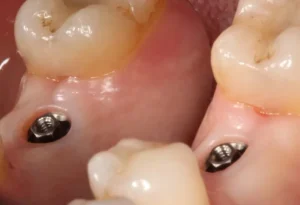Experiencing red gums around your dental implant can be a concerning symptom. This condition is often associated with inflammation, caused by factors such as improper implant placement, poor oral hygiene, or even an allergic reaction to the materials used in the implant. In some cases, red gums can indicate peri-implantitis, a serious disease that requires immediate attention. Understanding the causes of redness and seeking professional advice early can significantly enhance the health and longevity of your dental implants.
Causes of Red Gums After Dental Implant
Experiencing red gums after receiving a dental implant can be concerning for many patients. It’s important to understand that while some redness is normal during the healing process, persistent or severe redness can be a sign of underlying issues. Identifying the causes of red gums is crucial for ensuring the long-term success of the implant and overall oral health. Several factors can contribute to red gums post-implant, including inflammation, infection, and improper oral hygiene. Understanding these causes and managing them effectively can help mitigate complications and promote a healthier recovery.
Inflammation
Inflammation is a common response after dental implant surgery. The body’s natural healing process includes an inflammatory phase, which can cause redness, swelling, and discomfort around the implant site. This is typically a normal and temporary condition. However, if the inflammation persists, it could indicate issues such as peri-implant mucositis.
Peri-implant mucositis is characterized by inflammation of the soft tissues around the implant without bone loss. It is often caused by the accumulation of bacterial plaque. Regular and effective oral hygiene practices are essential to reduce the risk of developing peri-implant mucositis.
Signs of inflammation due to peri-implant mucositis include:
- Redness and swelling around the implant site
- Bleeding on probing
- Discomfort or tenderness
If the inflammation is not addressed promptly, it could progress to peri-implantitis, a more severe condition involving bone loss and increased risk of implant failure. Therefore, it’s critical to monitor any signs of persistent inflammation and seek professional care if needed.
If you found this information helpful, be sure to check out our other articles on dental implants and oral health to stay informed on maintaining a healthy smile.
Preventive Measures
Maintaining optimal oral health is crucial for avoiding the need for invasive dental procedures such as implants and bone regeneration. Implementing preventive measures can significantly reduce the risk of dental issues that may lead to tooth loss and subsequent treatments. In this section, we’ll explore effective preventive strategies, including proper oral hygiene and the importance of regular dental check-ups.
Proper Oral Hygiene
One of the most effective ways to prevent dental problems is by practicing proper oral hygiene. This involves brushing your teeth at least twice a day with fluoride toothpaste and flossing daily to remove plaque from areas your toothbrush can’t reach. Consistent oral care can prevent the buildup of plaque, which is a primary cause of cavities and gum disease.
Moreover, using mouthwash can help reduce the number of bacteria in your mouth, thereby improving overall oral health. It’s also important to replace your toothbrush every three to four months, or sooner if the bristles are frayed. Studies have shown that electric toothbrushes tend to be more effective at reducing plaque and gingivitis compared to manual toothbrushes.
A balanced diet also plays a critical role in maintaining oral health. Limiting sugary and acidic foods can help reduce the risk of tooth decay. Foods rich in calcium and phosphates, such as dairy products, nuts, and certain vegetables, can strengthen tooth enamel. Hydration is equally important, as saliva plays a significant role in neutralizing acids and protecting teeth.
To summarize, here are key components of proper oral hygiene:
- Brushing teeth twice daily with fluoride toothpaste
- Flossing daily to remove plaque
- Using mouthwash to reduce bacterial load
- Replacing toothbrushes every three to four months
- Maintaining a balanced diet and adequate hydration
Regular Dental Check-ups
Regular dental check-ups are essential for early detection and management of potential dental issues. Visiting your dentist at least twice a year allows for professional cleanings and exams, which are crucial for preventing the progression of minor issues into more severe conditions that could require extensive treatment.
During a dental check-up, your dentist will examine your teeth, gums, and mouth for any signs of problems like cavities, gum disease, and oral cancer. Early diagnosis can facilitate more straightforward and less invasive treatments, saving you time, discomfort, and money in the long run.
Professional cleanings are also a key component of dental check-ups. These cleanings remove tartar (hardened plaque) that can’t be eliminated through regular brushing and flossing alone. Tartar buildup can lead to gum disease, which is a primary cause of tooth loss in adults. Regular removal of tartar can therefore help maintain overall oral health. In addition to exams and cleanings, dental visits are an excellent opportunity to discuss any concerns or symptoms you may have noticed. This proactive communication with your dentist can lead to personalized advice and preventive strategies tailored to your specific needs.
By incorporating proper oral hygiene and regular dental check-ups into your routine, you can prevent many dental issues and maintain a healthy, beautiful smile. For more detailed information and tips on maintaining oral health, be sure to check out our other articles.
Treatment Solutions
Effective treatment solutions are essential for maintaining oral health and ensuring successful outcomes in dental procedures, including implantology and bone regeneration. The appropriate interventions help control infections, promote healing, and prevent complications. This section explores some of the most commonly used treatment methods.
Antibiotics
Antibiotics play a crucial role in preventing and treating infections associated with dental procedures. Prescribing the right antibiotic can significantly reduce the risk of postoperative infections. For instance, antibiotics such as amoxicillin and clindamycin are often used due to their efficacy against oral pathogens. Their use is particularly important in patients undergoing implant surgery, where the risk of bacterial contamination is high.
It’s important to follow a prescribed antibiotic regimen to maximize effectiveness and minimize antibiotic resistance. Patients should be educated on the importance of completing the entire course of antibiotics even if they start feeling better. This prevents the survival of any residual bacteria that could potentially lead to a recurrence of the infection and resistance against the antibiotic.
Antiseptic Mouthwash
Using an antiseptic mouthwash is another essential component in the treatment and prevention of oral infections. Mouthwashes containing chlorhexidine are widely recommended due to their broad-spectrum antimicrobial properties. Chlorhexidine has been proven to effectively reduce bacterial load, control plaque formation, and promote healing in the oral cavity.
In patients undergoing dental procedures like implant placement or bone grafting, a pre-procedural rinse with an antiseptic mouthwash can significantly lower the risk of infections by reducing the microbial count. Postoperative use further helps in maintaining oral hygiene and ensuring the successful integration of implants.
Professional Cleaning
Regular professional dental cleanings are fundamental in preventing periodontal diseases and maintaining overall oral health. Professional cleanings help remove plaque and tartar that cannot be eliminated by regular brushing and flossing alone. This is especially important for patients with dental implants, as they are more susceptible to peri-implantitis if proper hygiene is not maintained.
During professional cleanings, dentists can also monitor the condition of implants and surrounding tissues, identifying any early signs of complications. This allows for timely interventions, which are crucial for the longevity and success of dental implants. Regular visits to the dental office ensure that any issues are addressed promptly, reducing the risk of severe infections or implant failure.
For more insights on maintaining optimal oral health and the latest advancements in dental care, be sure to explore our other articles!
Common Questions About Red Gums Around Dental Implants
If you have noticed redness around your dental implants, you may have questions about its causes and how to address it effectively. Here’s a frequently asked question that might shed some light on the issue.
Why are my gums red around my dental implant?
Red gums around a dental implant can be a sign of inflammation or infection, typically caused by implant overloading, poor oral hygiene, or the development of peri-implantitis. It’s crucial to maintain good oral hygiene and visit your dentist regularly for check-ups to prevent and treat this condition efficiently.

My name is Salman Kapa, a 73-year-old expert in bone regeneration and dental implantology. With decades of experience in the field, I am dedicated to advancing our understanding of oral health and hygiene. Through my research and writing, I aim to contribute to the development of innovative solutions in dental care.




